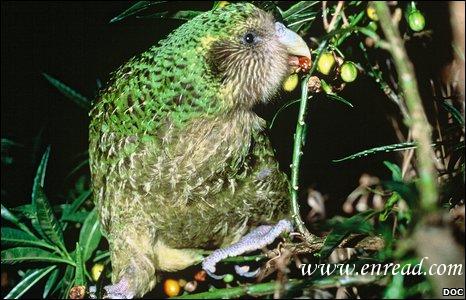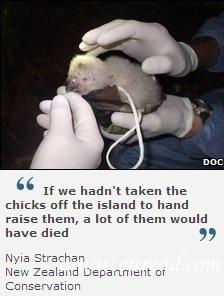| ||||||||||||||||||||||||||||||||||||||||||||||||||||||||||||||||||||||||
|
One of the world's rarest birds, New Zealand's kakapo, is now not quite so rare thanks to the arrival of 34 kakapo chicks. 世界稀有鸟类之一,新西兰鸮鹦鹉,因为34只小鹦鹉仔的出生而不是特别稀有了。 The breeding season coincides with the ripening1 of the kakapo's favourite fruit Those chicks, born over the past few months, take the world population of the flightless nocturnal(夜的) parrot ( Strigops habroptilus ) to 125. In 1995, kakapo numbers had dwindled(减少,缩小) to just 51. "It's critically endangered but it's in a healthier position than it was a decade ago," says Nyia Strachan, a communications officer at New Zealand's Department of Conservation. The prolific2(多产的) - by kakapo standards - breeding season was a combination of a group of females being mature enough to breed, and the prospect3 of a favourite kakapo food, rimurimu (芮木泪柏,新西兰产乔木)fruit. Those factors prompted the usually solitary4(孤独的) kakapo to perform their unusual courtship(求爱,求婚) ceremony, where the male makes a particular low boom from the top of a hill. It is a system of breeding known as "lek" and peculiar5(奇怪的), in parrots, to the kakapo. Fruit shortage It was clearly successful. But so many chicks were born that there was not enough ripe rimu fruit on the birds' island home, which is known as both Whenua Hou and Codfish Island. Twenty-one of the chicks are now being hand-reared in the nearby city of Invercargill. "If we hadn't taken the chicks off the island to hand raise them, a lot of them would have died," says Ms Strachan. Hand-rearing demands around-the-clock care from the kakapo team and many feeds. The younger chicks need at least 10 feeds a day while the older ones are fed about five times a day. For Don Merton, the renowned6(有名的,有声誉的) New Zealand conservationist(自然资源保护论者) who discovered the remnants(剩余的) of the kakapo population back in the 1970s and was intimately(密切地,熟悉地) involved with their care for more than 30 years, the milestone7 of a population of 100 birds was "fantastic". "It could never have happened without lots and lots of people over decades giving it their everything," says Mr Merton. Fat chicks: the youngest birds need up to 10 feeds per day Long life Until 1973, when 18 males were found in the rugged8(崎岖的,粗糙的) Fiordland area of New Zealand no one knew if the once-common kakapo still existed. Finding a small population which included females on Stewart Island, an island off the southern coast of the South Island of New Zealand, gave conservationists hope. Then, after years of painstaking9(辛苦的,勤勉的) effort, a large number of females born in 2002 helped ensure this year's crop of chicks. "Once they came on stream, once they matured, we knew we were going to have a very strong breeding lobby," says Mr Merton. "And it's all happened this year." The next milestone, Ms Strachan says, is to have 100 of the long-lived bird that the kakapo team knows the age of. "At the moment we have about 48 birds that we don't know the age of," she says. "It would be great to have a strong, healthy population that we know the ages of." Mr Merton's dream is for the kakapo population to reach 500 - and to be independent of the human help they now need to survive. "They'll need a lot of support for a long time yet," says Mr Merton, "but they are on the way." 点击  收听单词发音 收听单词发音
|
||||||||||||||||||||||||||||||||||||||||||||||||||||||||||||||||||||||||
- 发表评论
-
- 最新评论 进入详细评论页>>






